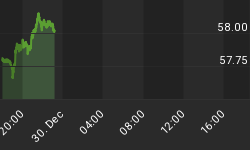The following is an excerpt from Pivotal Events March 15, 2007.
Signs Of The Times:
"As Goes Goldman, So Go Markets"
"Dubbed 'The Tell' Titan May Now Top Citigroup as Street's Best Indicator" - WSJ, March 13
"Mortgage Shakeout May Roil CDO Market"
"Subprime Defaults Lead to Wavering at Big Street Firms" - WSJ, March 13
Collateralized debt obligations (CDOs) are a securitization of a pool of individual mortgages and the volume of issuance of BBB, or lower, soared from around $5 billion weekly in September to around $22 billion in late February. The drop to around $7 billion looks like the conclusion of a blowoff.
However, despite the loss of liquidity in this sector, the financial future remains bright. The Fed will cut administered rates.
"The Fed is likely to only to NOT raise rates but should eventually lower them. When they do it will trigger a further expansion of the economy and help the bull market along even further." - March 9
Behaviour of Short Rates Following 3 Great Bull Markets |
1873: Soared to 9% and declined to 2.5% |
These are the biggest bull markets within the period when senior central banks could materially change the benchmark rate.
In 1873, it was the Bank of England's rediscount rate, in 1929 it was the Fed's discount rate, and in the 2000 example it was the Fed's targeted Fed funds rate.
In each case, the changes in the administered rate followed by a number of months the change in short-dated market rates of interest.
One observation is that during the period when the senior central bank could materially change its administered rate, interest rates have increased with a great boom and declined with the consequent contraction and bear market for stocks, commodities, and lower-grade bonds.
Another is that over the period of our review of the behaviour of short-dated market rates of interest, the most dramatic declines have only occurred following a financial mania.
In each case, the senior central bank followed the decline in market rates until near the end of the bear market; in so many words, rising short-dated market rates is one characteristic of a bull market. And, going the other way, declining rates is one characteristic of a bear market.
Treasury bill rates reached 5.18% on February 23 and have declined a little to today's 5.02%. Given the now rapid decline in liquidity in the sub-prime sector, the rippling out to the big bank stocks seems appropriate. Declining through 5.0% and accompanied by further steepening of the yield curve would indicate that the inevitable credit contraction has started.
In which case, it is best to recall the old saying the "Credit is suspicion asleep."
















